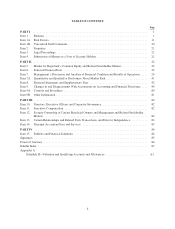LeapFrog 2009 Annual Report Download - page 19
Download and view the complete annual report
Please find page 19 of the 2009 LeapFrog annual report below. You can navigate through the pages in the report by either clicking on the pages listed below, or by using the keyword search tool below to find specific information within the annual report.
discussion of how our intellectual property rights may not insulate us from claims of infringement by third
parties, see Part I, Item 1A.—Risk Factors—“Third parties have claimed, and may claim in the future, that we
are infringing their intellectual property rights, which may cause us to incur significant litigation or licensing
expenses or to stop selling some of our products or using some of our trademarks.”
In addition to proprietary materials we have developed, we use various licensed technologies in some of our key
products, such as Leapster and Tag. For example, we use a version of Macromedia’s Flash player in our Leapster
handheld platform and we use optical pattern recognition hardware and software from Anoto AB in our Tag
reading systems. Our continued use of these rights is dependent on our continued compliance with applicable
license terms. Any failure to do so could interrupt our supply chain and require us to modify our products or
business plans. Please see Part I, Item 1A.—Risk Factors—“Our intellectual property rights include licenses
from third parties and may not prevent our competitors from using our technologies or similar technologies to
develop competing products, which could weaken our competitive position and harm our operating results” for
further discussion of the risks we face in relying on third party technology licenses for our products.
Seasonality
Our business is highly seasonal in both of our segments, with our retail customers making a large percentage of
all purchases in preparation for the traditional holiday season. Our business, being subject to these significant
seasonal fluctuations, generally earns the majority of our net sales and all of our net income, if any, during the
third and fourth calendar quarters. Our seasonal sales patterns for the years ended December 31, 2009, 2008 and
2007 are shown in the table below.
Years Ended December 31,
2009 2008 2007
Percent of total net sales:
1st quarter .......................................................... 8% 13% 14%
2nd quarter ......................................................... 13% 15% 13%
3rd quarter ......................................................... 29% 43% 32%
4th quarter ......................................................... 50% 29% 41%
Total .......................................................... 100% 100% 100%
These seasonal purchasing patterns and their related production lead times create risk in our business due to
possible under-production of popular items and over-production of items that do not match consumer demand. In
addition, as the most recent recession progressed, our retail customers managed their inventories more
stringently, requiring us to ship products closer to the time of expected consumer demand. If this trend continues,
it could increase the risk that we would be unable to meet the demand for specific products at peak demand
times. Similarly, this trend could have an adverse impact on our own inventory levels if we pre-build products to
meet anticipated demand that does not materialize. For more information about the effects of seasonality on our
business see Part I, Item 1A.—Risk Factors—“Our business is seasonal, and our annual operating results
depend, in large part, on sales relating to the brief holiday season.”
Financial Information about Geographic Areas
Financial information regarding export sales and international operations versus United States sales and
operations is included in Note 19—“Segment Reporting” in our Consolidated Financial Statements included in
this Form 10-K. For information regarding risks attendant to our foreign operations upon which our international
segment depends, see Part I, Item 1A.—Risk Factors—“Our international business may not succeed and subjects
us to risks associated with international operations.
9
























